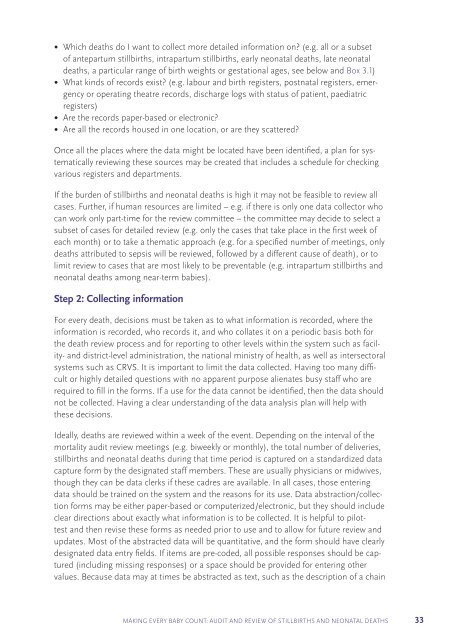Making Every Baby Count
9789241511223-eng
9789241511223-eng
Create successful ePaper yourself
Turn your PDF publications into a flip-book with our unique Google optimized e-Paper software.
• Which deaths do I want to collect more detailed information on? (e.g. all or a subset<br />
of antepartum stillbirths, intrapartum stillbirths, early neonatal deaths, late neonatal<br />
deaths, a particular range of birth weights or gestational ages, see below and Box 3.1)<br />
• What kinds of records exist? (e.g. labour and birth registers, postnatal registers, emergency<br />
or operating theatre records, discharge logs with status of patient, paediatric<br />
registers)<br />
• Are the records paper-based or electronic?<br />
• Are all the records housed in one location, or are they scattered?<br />
Once all the places where the data might be located have been identified, a plan for systematically<br />
reviewing these sources may be created that includes a schedule for checking<br />
various registers and departments.<br />
If the burden of stillbirths and neonatal deaths is high it may not be feasible to review all<br />
cases. Further, if human resources are limited – e.g. if there is only one data collector who<br />
can work only part-time for the review committee – the committee may decide to select a<br />
subset of cases for detailed review (e.g. only the cases that take place in the first week of<br />
each month) or to take a thematic approach (e.g. for a specified number of meetings, only<br />
deaths attributed to sepsis will be reviewed, followed by a different cause of death), or to<br />
limit review to cases that are most likely to be preventable (e.g. intrapartum stillbirths and<br />
neonatal deaths among near-term babies).<br />
Step 2: Collecting information<br />
For every death, decisions must be taken as to what information is recorded, where the<br />
information is recorded, who records it, and who collates it on a periodic basis both for<br />
the death review process and for reporting to other levels within the system such as facility-<br />
and district-level administration, the national ministry of health, as well as intersectoral<br />
systems such as CRVS. It is important to limit the data collected. Having too many difficult<br />
or highly detailed questions with no apparent purpose alienates busy staff who are<br />
required to fill in the forms. If a use for the data cannot be identified, then the data should<br />
not be collected. Having a clear understanding of the data analysis plan will help with<br />
these decisions.<br />
Ideally, deaths are reviewed within a week of the event. Depending on the interval of the<br />
mortality audit review meetings (e.g. biweekly or monthly), the total number of deliveries,<br />
stillbirths and neonatal deaths during that time period is captured on a standardized data<br />
capture form by the designated staff members. These are usually physicians or midwives,<br />
though they can be data clerks if these cadres are available. In all cases, those entering<br />
data should be trained on the system and the reasons for its use. Data abstraction/collection<br />
forms may be either paper-based or computerized/electronic, but they should include<br />
clear directions about exactly what information is to be collected. It is helpful to pilottest<br />
and then revise these forms as needed prior to use and to allow for future review and<br />
updates. Most of the abstracted data will be quantitative, and the form should have clearly<br />
designated data entry fields. If items are pre-coded, all possible responses should be captured<br />
(including missing responses) or a space should be provided for entering other<br />
values. Because data may at times be abstracted as text, such as the description of a chain<br />
MAKING EVERY BABY COUNT: AUDIT AND REVIEW OF STILLBIRTHS AND NEONATAL DEATHS<br />
33
















